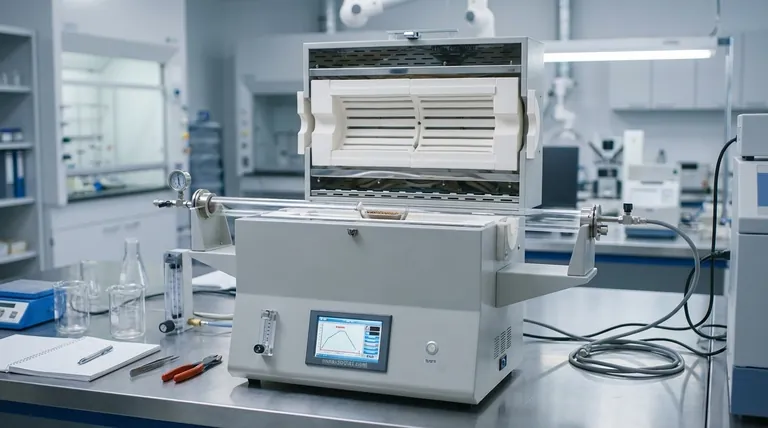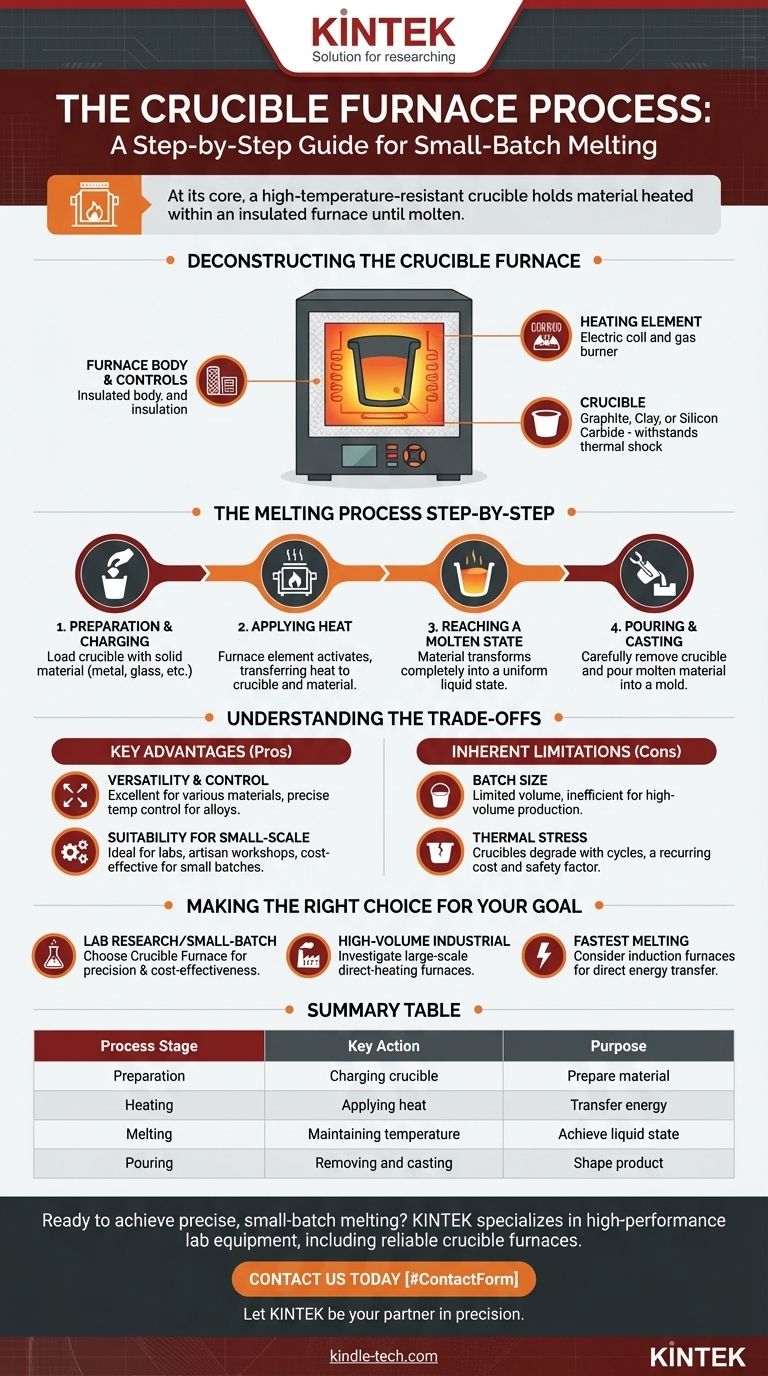At its core, the process of a crucible furnace is remarkably straightforward. A high-temperature-resistant container, known as the crucible, is loaded with the material to be melted. This crucible is then placed inside an insulated furnace where a heating element raises its temperature, transferring heat to the material until it becomes a molten liquid, ready for pouring.
The true value of a crucible furnace lies not just in its process, but in its function as a self-contained, versatile, and controllable system for melting small batches of material with high precision.

Deconstructing the Crucible Furnace
To understand the process, you must first understand its core components. The entire system is designed for one purpose: to safely contain and transfer heat into a specific material.
The Heating Element
The engine of the furnace is its heating element. This can be powered by electricity (using resistance coils) or by gas (using a high-output burner), generating the intense heat required for melting.
The Crucible
This is the heart of the operation. The crucible is a removable pot made from materials like graphite, clay, or silicon carbide that can withstand extreme thermal shock. It serves two critical functions: holding the raw material (the "charge") and keeping it separate from the furnace's heat source to prevent contamination.
The Furnace Body and Controls
The furnace body is an insulated chamber that traps and concentrates the heat around the crucible, maximizing efficiency. Modern furnaces also include temperature control systems, which are crucial for precisely managing the melting process for different materials.
The Melting Process Step-by-Step
While simple in concept, the process requires careful execution at each stage to ensure safety and a quality result.
1. Preparation and Charging
The process begins by placing the solid material—be it metal, glass, or another substance—directly into the crucible. This is known as "charging" the crucible.
2. Applying Heat
The charged crucible is placed inside the furnace. The heating element is activated, which heats the air and furnace walls around the crucible. This heat is then transferred through the crucible walls into the material inside.
3. Reaching a Molten State
The furnace maintains its high temperature, continuously transferring energy into the material until it reaches its specific melting point and transforms completely into a liquid state. This is often called the "molten" state.
4. Pouring and Casting
Once the material is fully molten, the furnace is opened, and the glowing crucible is carefully removed using specialized tongs. The molten material is then immediately poured into a mold to create the final desired shape.
Understanding the Trade-offs
While highly effective, the crucible furnace process comes with inherent trade-offs that make it suitable for some applications but not others.
Key Advantage: Versatility and Control
Because the material is isolated within the crucible, this method is excellent for melting a wide range of materials without cross-contamination. The precise temperature controls make it ideal for alloys and materials with strict melting requirements.
Key Advantage: Suitability for Small-Scale Work
The compact size and relatively simple operation make crucible furnaces a mainstay in laboratories, small foundries, and artisan workshops. They are cost-effective for small, specialized batches.
Inherent Limitation: Batch Size
The size of the crucible directly limits the amount of material you can melt at one time. This makes the process inefficient for large-scale, high-volume industrial production.
Inherent Limitation: Thermal Stress
Crucibles are consumables. They endure immense thermal stress with each heating and cooling cycle, which eventually causes them to degrade and crack. This represents a recurring operational cost and a potential safety hazard if not monitored.
Making the Right Choice for Your Goal
Selecting the right melting technology depends entirely on your objective.
- If your primary focus is laboratory research or small-batch custom casting: A crucible furnace is almost certainly the right choice for its precision, versatility, and cost-effectiveness.
- If your primary focus is high-volume industrial production: You should investigate larger-scale direct-heating furnaces, as the crucible process will be a significant bottleneck.
- If your primary focus is melting a single type of metal as fast as possible: An induction furnace might be a more energy-efficient solution, as it heats the material directly rather than heating a container first.
Ultimately, understanding the complete process and its trade-offs empowers you to align your tools with your specific material-processing goals.
Summary Table:
| Process Stage | Key Action | Purpose |
|---|---|---|
| Preparation | Charging the crucible with material | Prepare the material for melting |
| Heating | Applying heat via element (electric/gas) | Transfer energy to melt the material |
| Melting | Maintaining temperature until molten | Achieve a uniform liquid state |
| Pouring | Removing crucible and casting into a mold | Shape the final product |
Ready to achieve precise, small-batch melting in your lab?
KINTEK specializes in high-performance lab equipment, including crucible furnaces designed for reliability and control. Whether you're in R&D, a small foundry, or an artisan workshop, our solutions help you melt a wide range of materials with precision and minimal contamination.
Contact us today using the form below to discuss your specific melting needs and discover the right furnace for your goals. Let KINTEK be your partner in precision.
Visual Guide

Related Products
- 1400℃ Laboratory Quartz Tube Furnace with Alumina Tube Tubular Furnace
- 1700℃ Laboratory Quartz Tube Furnace with Alumina Tube Tubular Furnace
- Vertical Laboratory Quartz Tube Furnace Tubular Furnace
- Laboratory Quartz Tube Furnace Tubular RTP Heating Furnace
- High Temperature Muffle Oven Furnace for Laboratory Debinding and Pre Sintering
People Also Ask
- What are the benefits of a tube furnace? Achieve Superior Temperature & Atmosphere Control
- How does a tubular furnace work? A Guide to Controlled High-Temperature Processing
- What is the high temperature of a tube furnace? Unlock the Right Model for Your Application
- What precautions should be taken when using a tube furnace? Ensure Safe, Effective High-Temperature Processing
- What are the advantages of a tube furnace? Achieve Superior Temperature Uniformity and Control



















